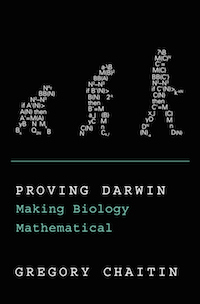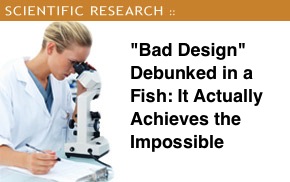BIO-Complexity Paper: Why Chaitin's Mathematical "Proof" of Darwinian Evolution Fails
 A new peer-reviewed paper in BIO-Complexity, "Active Information in Metabiology," reports on the further investigations of the Evolutionary Informatics Lab
into the ability of unguided evolutionary mechanisms to produce new
information. This time, authors Winston Ewert, William Dembski, and
Robert Marks show that the budding field of metabiology only produces
creative outputs through active information -- i.e., informational
inputs donated by an intelligent source -- and does not truly
demonstrate that unguided processes can produce new information.
A new peer-reviewed paper in BIO-Complexity, "Active Information in Metabiology," reports on the further investigations of the Evolutionary Informatics Lab
into the ability of unguided evolutionary mechanisms to produce new
information. This time, authors Winston Ewert, William Dembski, and
Robert Marks show that the budding field of metabiology only produces
creative outputs through active information -- i.e., informational
inputs donated by an intelligent source -- and does not truly
demonstrate that unguided processes can produce new information.
What is "metabiology"? According to the paper, it's "a fascinating intellectual romp in the surreal world of the mathematics of algorithmic information theory" where "halting oracles hunt for busy beaver numbers and busy beaver numbers unearth Chaitin's number, knowledge of which in turn allows resolution of numerous unsolved mathematical problems, many of whose solutions would earn large cash bounties." That description may not help most of us very much. The field of "metabiology" was developed by the Argentine-American computer scientist and mathematician Gregory Chaitin. In his 2013 book Proving Darwin: Making Biology Mathematical, Chaitin describes metabiology as an "answer" to David Berlinski's "stinging critique of Darwinism" in The Devil's Delusion. "Metabiology" is Chaitin's attempt to use mathematics and (hypothetical) computer simulations to formally prove that Darwinian theory can create new information. It relies on an inherently gene-centered view of evolution, where a simulated "genetic code" (i.e., a computer program) can be "mutated," and when the program "halts" or stops running, it outputs a number that correlates with the program's "fitness." If the number goes up as the evolutionary simulation proceeds, Chaitin thinks he's shown Darwinian processes can increase fitness over time.
There are many reasons why Chaitin's model does not accurately reflect how Darwinian evolution works, if it does work, in the real world of biology (some of which are summarized nicely over at Theory, Evolution, and Games Group). Not the least of such problems is the fact that the simulation basically grants itself infinite probabilistic resources (actually, computing resources, but that's analogous to probabilistic resources in biology).
As Ewert, Dembski, and Marks explain:
Because metabiology programs have unbounded length and can run for an unbounded amount of time, the unboundedness essentially undermines the creativity required to solve the large-number problem. With unbounded resources and unbounded time, one can do most anything.In the real world, probabilistic resources are limited. Time is finite, and populations have finite sizes, and this imposes limits on what traits can evolve especially (as Stephen Meyer shows in Darwin's Doubt) when traits require multiple mutations before providing some advantage. Metabiology uses a population of one single "digital organism," which then "evolves" over time, but it grants itself essentially infinite computing resources to do this. With such a generous endowment, sure, anything can eventually evolve. But we don't live in an unlimited world, which is precisely why Darwinian evolution faces major theoretical problems. They thus write:
Although elegant in conception, metabiology departs from reality because it pays no attention to resource limitations. Metabiology's math obscures the huge amounts of time required for the evolutionary process. The programs can run for any arbitrarily large number of steps. Additionally, programs can be of any length with no penalty imposed for longer programs.Ewert, Dembski, and Marks explain that Chaitin's program uses a halting oracle as a source of "active information." A halting oracle is a hypothetical meta-program that can tell you if a given program will ever stop running. As they explain, such an oracle could be useful in disproving certain mathematical conjectures, such as Goldbach's conjecture, "which hypothesizes that all even numbers greater than two can be written as the sum of two primes." They discuss how a halting oracle could determine if the conjecture was false:
Suppose a program X can be written to test each even number sequentially to see if it were the sum of two primes. If a counterexample is found, the program stops and declares "I have a counterexample!" Otherwise, the next even number is tested. If Goldbach's conjecture is true, the program will run forever.The difficulty for Chaitin is he admits that for metabiology, "[The halting oracle] is where all the creativity is really coming from in our program," but also admits that such an oracle is "mathematical fantasy." Ewert, Dembski, and Marks thus aptly observe, "A computer tool proven not to exist is admittedly at the outset an obvious major strike against a theory purporting to demonstrate reality."If a halting oracle existed, we could feed it X. If the halting oracle says "this program halts," Goldbach's conjecture is disproved. A counterexample exists. If the halting oracle says, "This program never halts," then Goldbach's conjecture is proven! There exists no counterexample.
Now at this point, one might reasonably ask, "If a halting oracle is a hypothetical fantasy, how can Chaitin claim to use one in metabiology?" The answer is that Chaitin isn't actually creating a computer program. He's seeking a mathematical proof of the Darwinian model, where he's allowed to indulge thought experiments that invoke hypothetical entities. All he needs to be able to do is to prove what might happen if he theoretically had a halting oracle. But it doesn't help that one could never exist.
That problem aside, they explain that the "halting oracle" used by Chaitin's program has three different options of how to find a search target: "
- Exhaustive Search (poor)
- Random Evolution (good)
- Intelligent Design (better)
Which, again, is nothing like how the real world of biology, where an organism is forced to rely on the genome it receives, which at best will have just a few small mutational differences from its parents. Darwinian evolution in real biology requires a grueling ascent of mount improbable, but Chaitin's program can fly wherever it wants at any time. To put it another way, metabiology cheats by giving a digital organism unrealistic access to any program at any time which will lead to a higher fitness state. As Ewert, Dembski, and Marks explain:
As any computer programmer will tell you, landscapes of computer program fitness are the opposite of smooth. We would therefore not expect Darwinian evolution to fare well. Chaitin notes this when he writes [3], "The fitness landscape has to be very special for Darwinian evolution to work."Chaitin also presents a different model that uses what he calls "intelligent design" to find a search target. This obviously doesn't help show what unguided evolutionary processes can accomplish. The author of the blog "Theory, Evolution and Games Group" critiques Chaitin's model, writing that metabiology uses "a teleological model -- a biologist's nightmare." Ewert, Dembski, and Marks explain:The environment for evolution to occur, therefore, has to be carefully designed. Indeed, in the paradigm of conservation of information, smooth landscapes can be source of significant active information [14]. Metabiology's construction of smooth landscapes is accomplished by running all viable programs, a computationally expensive approach that is only possible because there are no resource limitations.
Like AVIDA and ev, metabiology makes use of external information sources to assist in the search. Like the simple Hamming oracle, the halting oracle can be mined for information with various degrees of sophistication. Evolution thus requires external sources of knowledge to work. The degree to which this knowledge is used can be assessed using the idea of active information.They conclude: "In order for evolution to occur in these models, external knowledge must be imposed on the process to guide it. Metabiology thus appears to be another example where its designer makes an evolutionary model work. ... Consistent with the laws of conservation of information, natural selection can only work using the guidance of active information, which can be provided only by a designer." Properly understood, in other words, these programs demonstrate that evolution requires intelligent design.



